Sold Ceramics
Sold Blue and White Kangxi Period 1662-1722
Other Vases
Page 1
Around 1680, Emperor Kangxi (1662–1722) established his authority over all parts of China after a long period of civil strife. The porcelain factories in Jingdezhen that were demolished in 1675 resumed production and within a few years exports were booming. Chinese junks sailed to Batavia, bringing their porcelain to the market. From there, it was shipped to the Netherlands in VOC (Dutch East India Company, 1602–1799) vessels. However, private individuals bypassed the Company and also imported huge quantities of porcelain to Holland. In Europe, a change in dining habits and the introduction of tea and coffee created new demands. New varieties of Chinese export porcelain were produced, including all kinds of Western shapes. Porcelain, sometimes in miniature, was frequently used to decorate house interiors in Europe.
Much porcelain of this period is decorated in a clear, transparent underglaze blue. Popular decorations included the Buddhist lotus motif, a pheasant with long tail feathers on a rock amidst flowers, and the ‘Long Eliza’ with the 'Dancing Fool', the Dutch name for a Chinese lady and a small boy depicted in a garden.
Kangxi porcelain is very well made, with a thin body, a balanced shape and a smooth glaze without impurities. Cobalt blue oxide was subtly applied in varying degrees of saturation, suggesting depth and volume. The colour ranges from a silvery to a deep dark blue; in the best pieces the details and the craftsmanship are amazing. However, due to stricter controls by officials, the freedom and easy way of painting that was so characteristic of the preceding Transitional period now gave way to a more formal style with an emphasis on symmetry and centralism.
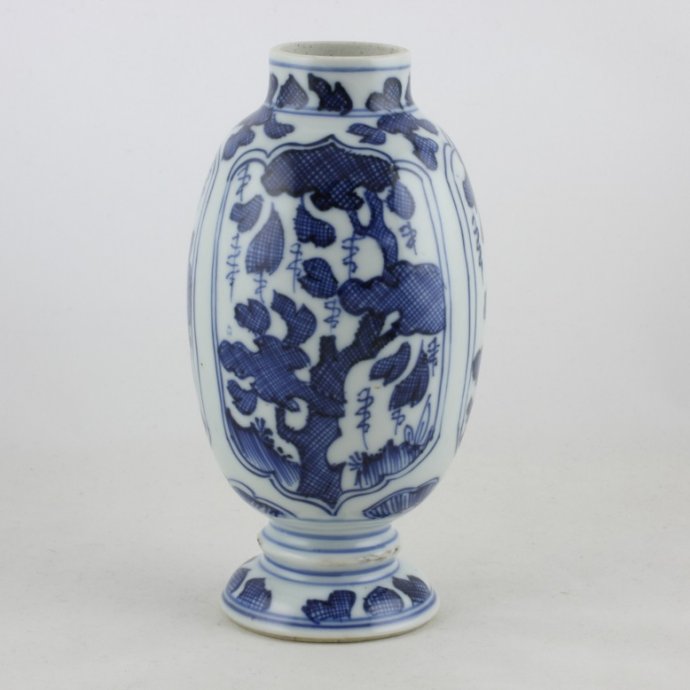
Sold Ceramics - Sold Blue and White Kangxi Period 1662-1722 - Other Vases - Page 1
Object 2010479
Vase
China
c.1700
Height 140 mm (5.12 inch), diameter 70 mm (2.76 inch), diameter of mouthrim 30 mm (1.18 inch), diameter of footring 50 mm (1.97 inch), weight 263 grams (9.28 ounce (oz.))
Large oviform vase on a footring, splayed foot, deep base, a flat knob between the foot and the elongated ovoid body with an upright neck. Rim unglazed inside for cover, now missing. Decorated in underglaze blue with, so-called, hatching lines technique with on the foot leaves, on the body three lotus-petal panels filled with leafy branches. Around the neck also a scroll of single leaves.
These criss-cross hatching lines are not a Chinese way of painting on porcelain and may have been influenced by the Dutch. This technique was short-lived for it mostly occurs on blue-and-white export wares around 1700. It occurs on teacups and saucers, beakers and small jars with covers, garnitures and other items. The style was short lived, disappearing in the early 18th century. (Jörg & Flecker 2001, pp.68-69)
Condition: A glaze frit and chip to the flat knob between the foot and the elongated ovoid body.
References:
Jörg & Van Campen 1997, cat. 117
Jörg & Flecker 2001, cat. 55-58
Price: Sold.

Sold Ceramics - Sold Blue and White Kangxi Period 1662-1722 - Other Vases - Page 1
Object 201086
Vase
China
c.1700
Height 130 mm (5.12 inch), diameter 53 mm (2.09 inch), diameter of mouthrim 25 mm (0.98 inch), diameter of footring 40 mm (1.57 inch), weight 157 grams (5.54 ounce (oz.))
Six sided vase on footing. Rim unglazed inside for cover, now missing. Decorated in underglaze blue, so-called, criss-cross hatching lines technique, on all six sides, neck and foot, with leafy branches and leaves, Around the neck and rim a zig-zag lines pattern border. Marked on the base with the symbol mark: Artemisia leaf, underglaze blue.
These criss-cross lines are not a Chinese way of painting on porcelain and may have been influenced by the Dutch. This technique was short-lived for it mostly occurs on blue-and-white export wares around 1700. It occurs on teacups and saucers, beakers and small jars with covers, garnitures and other items. The style was short lived, disappearing in the early 18th century. (Jörg & Flecker 2001, pp. 68-69)
For a similarly shaped and decorated vase, please see
Condition: Some tiny shallow frits to the footring and mouthrim.
References:
Jörg & Flecker 2001, fig 55-58
Price: Sold.

Sold Ceramics - Sold Blue and White Kangxi Period 1662-1722 - Other Vases - Page 1
Object 2011940
Vase
China
c.1700
Height 124 mm (4.88 inch), diameter 41 mm (1.61 inch), diameter of mouthrim 26 mm (1.02 inch), diameter of footring 35 mm (1.38 inch), weight 118 grams (4.16 ounce (oz.)),
Cylindrical vase on a footring, the short neck flaring outward at the top with an upturned edge. Decorated in underglaze blue with two baskets, each on a low table, one with a ruyi-sceptre the other with a precious object, in between the baskets a precious object. On the flat shoulder two precious objects. Marked on the base with the single character mark: Yu, (Jade (Yuan to Qing)), in underglaze blue.
Ruyi (如意, lit. 'as desired'; as [you] wish) is a curved decorative object that serves as a ceremonial sceptre in Chinese Buddhissm or a talisman symbolizing power and good fortune in Chinese folklore. A traditional ruyi has a long S-shaped handle and a head fashioned like a fist, cloud, or lingzhi mushroom. (source: Wikipdia)
The Yu, 'jade', character mark is traditionally called the F-mark in the Netherlands and is very common on good-quality blue and white Kangxi export porcelain. (Jörg & Van Campen 1997, p.115)
Vases of this shape first appeared in the 1680s and were among the characteristic wares of the Kangxi period, but their production later gradually waned. Porcelain objects of smaller dimensions represented an important segment of imported goods, because they served in Europe as supplementary ornaments of aristocratic interiors. (Suchomel 2015, p.183, cat. 66)
For similarly shaped or decorated vases, please see:
- Chinese ceramiek, catalogue Haags Gemeentemuseum, (B. Jansen, De Tijdstroom, Lochem, 1976), p.105, cat. 241.
- Pronken met Oosters Porselein, exhibition catalogue Gemeentemuseum Arnhem, (S. Hartog, Zwolle, 1990), p.83, cat. 81.
- 300 Treasures, (F. Suchomel, Academy of Arts, Architecture and Design in Prague, Prague, 2015), p.183, cat. 66.
Condition: A firing flaw and some tiny fleabites to the footring.
References:
Jörg & Van Campen 1997, cat. 116
Price: Sold.

Sold Ceramics - Sold Blue and White Kangxi Period 1662-1722 - Other Vases - Page 1
Object 2011018
Baluster vase converted into a sugar caster.
China
1700-1720
Height with cover 137 mm (5.39 inch), diameter 58 mm (2.28 inch), diameter of mouthrim 35 mm (1.38 inch), diameter of base 37 mm (1.46 inch), weight with cover 232 grams (8.18 ounce (oz.)), weight cover 11 grams (0.39 ounce (oz.))
Baluster vase on footring. Fitted with marked (1846) Dutch silver mounts converting it into a sugar caster. Decorated in underglaze blue with a parrot, perched on a branch, in a lobbed medallion alternating with flowering plants within two broad bands filled with scroll work. Round the foot a descending lotus leaves-pattern border, the mouthrim with a lappet-pattern border and two butterflies in flight. The silver marks explained: the makers mark or year letter 'L' which stands for the date mark 1846, the sword mark was used (1814-1905) as the standard mark on articles too small for the full hallmarking.
The parrot exists as a well-documented, independent European design that was widely popular at a time when merchants and travellers first collected parrots as emblems of exotic lands. As early as 1580, the Antwerp engraver Adrian Collaert (1560-1618) published a series of bird prints, among which was an image of two birds on stumps, one of which eats cherries. (Sargent 2012, pp.510-511)
For an identically, shaped, sized and decorated baluster vase, please see:
- Sold Ceramics - Sold Blue and White Kangxi Period 1662-1722 - Other Vases - Page 1 - Object 2011374.
Condition: Scratches to the glaze where the mount fits the body.
Reference:
Price: Sold.
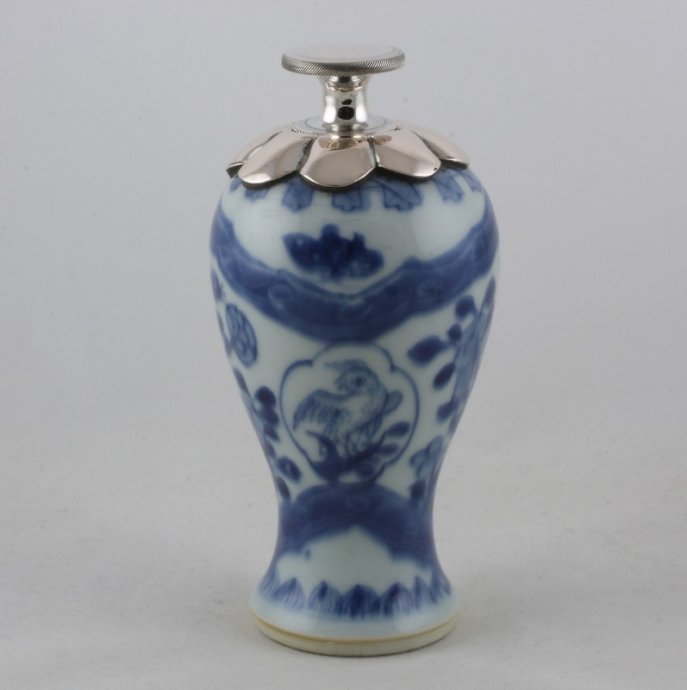
Sold Ceramics - Sold Blue and White Kangxi Period 1662-1722 - Other Vases - Page 1
Object 2011374
Baluster vase
China
1700-1720
Height with cover 135 mm (5.31 inch), diameter 60 mm (2.36 inch), diameter of mouthrim 23 mm (0.91 inch), diameter of base 40 mm (1.57 inch), weight with cover 275 grams (9.70 ounce (oz.)), weight cover 13 grams (0.46 ounce (oz.))
Baluster vase on footring. Fitted with marked (1845) and engraved Dutch silver mounts. Decorated in underglaze blue with a parrot, perched on a branch, in a lobbed medallion alternating with flowering plants within two broad bands filled with scroll work. Round the foot a descending lotus leaves-pattern border, the mouthrim with a lappet-pattern border and two butterflies in flight. The silver marks explained: the makers mark or year letter 'L' which stands for the date mark 1845, the sword mark was used (1814-1905) as the standard mark on articles too small for the full hallmarking.
The parrot exists as a well-documented, independent European design that was widely popular at a time when merchants and travellers first collected parrots as emblems of exotic lands. As early as 1580, the Antwerp engraver Adrian Collaert (1560-1618) published a series of bird prints, among which was an image of two birds on stumps, one of which eats cherries. (Sargent 2012, pp.510-511)
Condition: Perfect.
Reference:
Price: Sold.

Sold Ceramics - Sold Blue and White Kangxi Period 1662-1722 - Other Vases - Page 1
Object 2010265
Baluster vase
China
1700-1720
Height including cover 146 mm (5.75 inch), diameter 72 mm (2.83 inch), diameter of mouthrim 22 mm (0.87 inch), diameter of footring 37 mm (1.46 inch), weight with cover 191 grams (6.74 ounce (oz.)), weight cover 5 grams (0.18 ounce (oz.))
Baluster vase on footring. Dutch silver mounts (marked) on the neck engraved with an anchor within a heart. On top of the cover engraved with '1926'. Decorated in underglaze blue, with a squirrel climbing through branches of vine. The silver marks explained: The sword mark was used (1814-1905) as the standard mark on articles too small for the full hallmarking. What the letters CAZ stand for is unknown.
In traditional Chinese and Japanese cultures, images of squirrels and grapes together formed a rebus signifying a wish to have many sons. Squirrels and grape images appear in Chinese painting as early as the thirteenth century an in Chinese porcelain as early as the sixteenth century. Japanese decorators began using the design on Kakiemon-style porcelains in the seventeenth century, and it spread to Europe in the eighteenth century. The design was first copied in Europe at the Meissen factory and was imitated later by many other factories in France and England, Because the Europeans did not know the origin of the design, they sometimes mistook the squirrel for a rat and called it the 'rat and grape' design. (Impey, Jörg & Mason 2009, p.146, Fig, 102)
The depiction of vines with squirrels was a very popular, repeated pattern on a range of craftwork since the Ming Dynasty, but especially on porcelain, stoneware and snuff bottles. The squirrel, which can bear offspring more than once a year, symbolizes fertility, as does the vine with abundant grapes, and both motifs were used primarily as auspicious symbols intended to bring to the recipient a great number of sons and grandsons. Symbolism of this kind was developed as early as in the Tang Dynasty and later also reached Japan, where similar patterns always represented a tradition adopted from continental Asia, The pattern appeared quite frequently on Chinese porcelain as is demonstrated by several examples in a range of collections worldwide. (Suchomel 2015, p.228, cat.109)
For other objects decorated with the 'squirrel and grape' pattern, please see:
- Dragons, Tigers and Bamboo: Japanese Porcelain and its impact in Europe - The Mac-Donald Collection, (O.Impey, C.J.A. Jörg and C. Mason, Douglas & McIntyre Publishers Inc., Vancouver/Toronto/Berkeley 2009), p.146, Fig. 102.
- 300 Treasures, (F. Suchomel, Academy of Arts, Architecture and Design in Prague, Prague, 2015), p.228, cat. 109.
Condition: An unglazed part to the outer footring, one tiny frit and a tiny chip to the underside of the footring and two firing flaws to the inner footring.
References:
Impey, Jörg & Mason 2009, Fig, 102
Price: Sold.
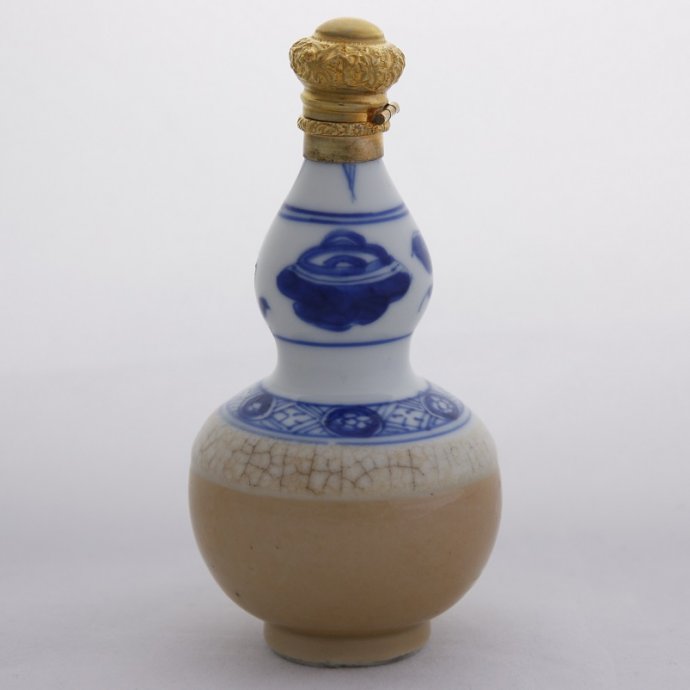
Sold Ceramics - Sold Blue and White Kangxi Period 1662-1722 - Other Vases - Page 1
Object 2010213
Double-gourd vase
China
c.1700
Height with mount 105 mm (4.13 inch), diameter 53 mm (2.09 inch), diameter of footring 25 mm (0.98 inch)
Double-gourd vase on footring Fitted with a gilt-bronze (ormolu) mount (unmarked). Decorated in underglaze blue, the lower part of the body is covered with underglaze light brown, on the shoulder a trellis pattern border with reserves filled with a single flower head. Round the neck decorated with antiquities.
For a similar shaped and decorated double-gourd vase, please see:
Condition: Perfect.
References:
Jörg & Van Campen 1997, cat. 140
Price: Sold.
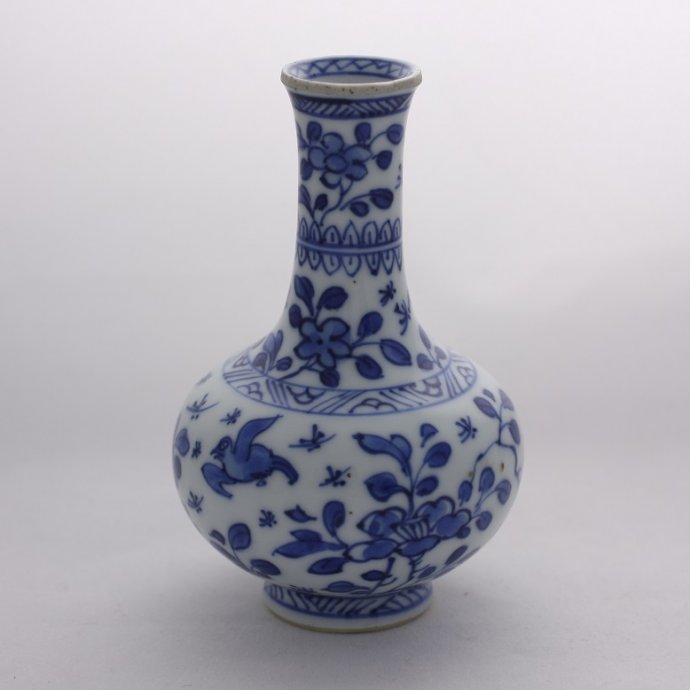
Sold Ceramics - Sold Blue and White Kangxi Period 1662-1722 - Other Vases - Page 1
Object 201085
Vase
China
1700-1720
Height 100 mm (3.93 inch), diameter 66 mm (2.59 inch), diameter of mouthrim 22 mm (0.87 inch), diameter of footring 30 mm (1.18 inch), weight 116 grams (4.09 ounce (oz.))
Vase on footring. Decorated in underglaze blue with around the foot a zig-zag lines pattern border on the body and neck a continuous decoration with flowers, insects and birds flight. On the inner and outer rim zig-zag lines pattern borders.
The last two images are of a similarly vase sold by Mr. F.J. Haffmans Kunst en Antiekhandel, Utrecht, the Netherlands, (this vase is not included in this sale/offer)
Condition: A smoothened rim.
Price: Sold.

Sold Ceramics - Sold Blue and White Kangxi Period 1662-1722 - Other Vases - Page 1
Object 2010260
Bottle vase
China
c.1700
Height 84 mm (3.30 inch), diameter 56 mm (2.21 inch), diameter of mouthrim 10 mm (0.39 inch), diameter of footring 25 mm (0.98 inch), weight 67 grams (2.36 ounce (oz.))
Bottle vase on footring, compressed globular body surmounted by a tall narrow cylindrical neck. Decorated in underglaze blue with a bird in flight below sprays of plum blossom, round the foot a band of ascending lotus petals in low relief.
For similarly decorated bottle vase, please see:
Condition: A frit and fleabite to the rim and some glaze frits and spots on the waist caused by popped bubbles of glaze during the firing process.
Reference:
Price: Sold.

Sold Ceramics - Sold Blue and White Kangxi Period 1662-1722 - Other Vases - Page 1
Object 2011354
Bottle vase
China
c.1700
Height 92 mm (3.62 inch), diameter 56 mm (2.20 inch), diameter of mouthrim 8 mm (0.31 inch), diameter of footring 20 mm (0.79 inch)
Bottle vase on footring, compressed globular body surmounted by a tall narrow cylindrical neck, fitted with an unmarked silver mount. Decorated in underglaze blue with a bird in flight below sprays of plum blossom, round the foot a band of ascending lotus petals in low relief. The silver mount is engraved with garlands and scattered flower heads.
Condition: A firing flaw to the exterior footring.
Price: Sold.
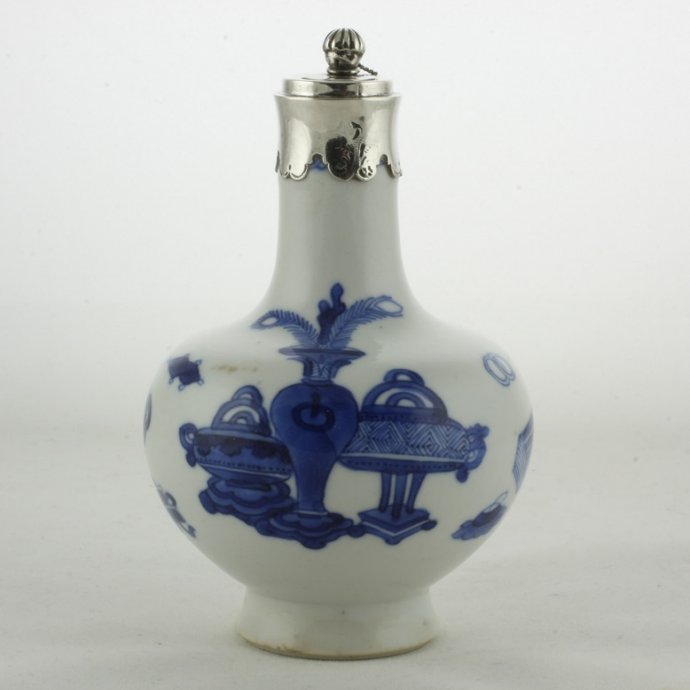
Sold Ceramics - Sold Blue and White Kangxi Period 1662-1722 - Other Vases - Page 1
Object 2010980
Vase
China
c.1700
Height with cover 102 mm (4.01 inch), diameter 68 mm (2.68 inch), diameter of mouthrim 19 mm (0.75 inch), diameter of footring 32 mm (1.26 inch)
Baluster shaped vase on footring. Fitted with Dutch silver mounts (marked). Decorated in underglaze blue with various precious objects, baskets on a table and a vase filled with peacock feathers. The silver mount is marked with a sword, the sword mark was used (1814-1905) as the standard mark on articles too small for the full hallmarking.
For a similarly decorated teapot, please see:
Condition: A firing flaw to the footring.
Reference:
Price: Sold.
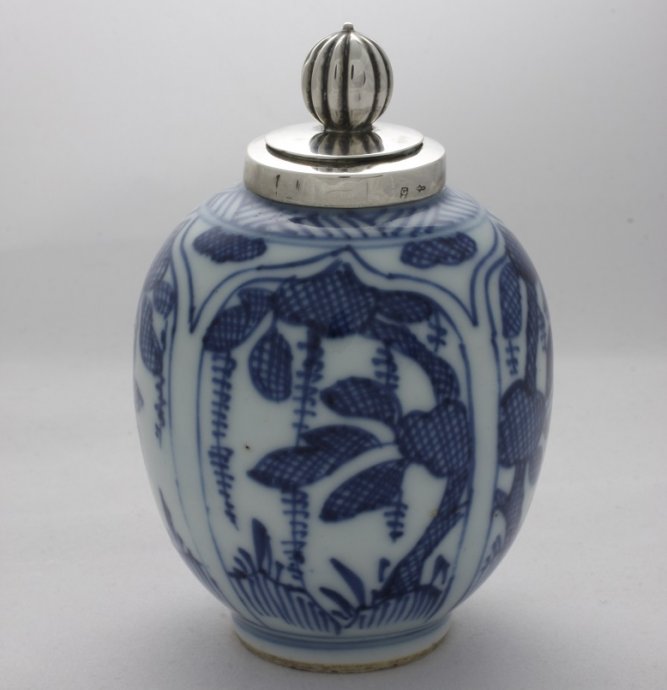
Sold Ceramics - Sold Blue and White Kangxi Period 1662-1722 - Other Vases - Page 1
Object 2010211
Vase
China
c.1700, the Dutch silver mounts marked, 1841.
Height with cover 95 mm (3.74 inch), diameter 63 mm (2.48 inch), diameter of mouthrim 22 mm (0.87 inch), diameter of footring 30 mm (1.18 inch)
Vase of ovoid form on footring. Fitted with Dutch silver mounts (marked). Decorated in underglaze blue with four panels filled with floral sprays painted in hatching-lines technique. Around the shoulder a zig-zag lines pattern border. The silver marks explained, the sword mark was used (1814-1905) as the standard mark on articles too small for the full hallmarking. The letter G stands for the date mark 1841.
These criss-cross hatching lines are not a Chinese way of painting on porcelain and may have been influenced by the Dutch. This technique was short-lived for it mostly occurs on blue-and-white export wares around 1700. It occurs on teacups and saucers, beakers and small jars with covers, garnitures and other items. The style was short lived, disappearing in the early 18th century. (Jörg & Flecker 2001, pp.68-69)
Condition: Perfect.
References:
Jörg & Van Campen 1997, cat. 117
Jörg & Flecker 2001, fig 55-58
Price: Sold.
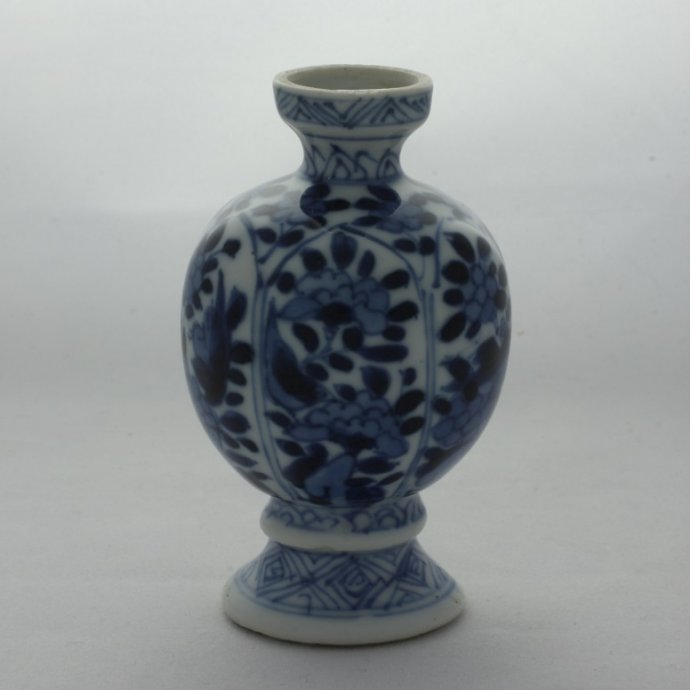
Sold Ceramics - Sold Blue and White Kangxi Period 1662-1722 - Other Vases - Page 1
Object 2010261
Small vase
China
1700-1720
Height 70 mm (2.76 inch), diameter 42 mm (1.65 inch), diameter of mouthrim 16 mm (0.63 inch), diameter of footring 28 mm (1.10 inch), weight 57 grams (2.01 ounce (oz.))
Small vase on footring. Rim unglazed inside for cover, now missing. Decorated in underglaze blue with a trellis pattern border around the foot, on the body six panels filled with flowering plants growing from rockwork and a single bird perched or in flight. Round the neck a ascending pointed lotus leaves-pattern border and round the rim a zig-zag lines pattern border. Marked on the base with the single character mark: Yu, (Jade (Yuan to Qing)), underglaze blue. The vase stands crooked due to the firing process.
The Yu, 'jade', character mark is traditionally called the 'F-mark' in the Netherlands and is very common on good-quality blue-and-white Kangxi export porcelain. (Jörg & Van Campen 1997, p.115)
Condition: A Y-shaped hairline to the rimand two glaze frits to the waist rib.
References:
Jörg & Van Campen 1997, cat. 116
Price: Sold.

Sold Ceramics - Sold Blue and White Kangxi Period 1662-1722 - Other Vases - Page 1
Object 2010210
Vase
China
1700-1720
Height 89 mm (3.50 inch), diameter 60 mm (2.36 inch), diameter of mouthrim 22 mm (0.87 inch), diameter of footring 35 mm (1.38 inch)
A spirally moulded ovoid vase on footring. Decorated in underglaze blue with a continuous decoration of flowering branches and insects in flight. Around the neck and foot a spiral pattern border.
Condition: A few tiny fleabites and a small firing flaw to the rim, two chips to the footring.
Reference:
Price: Sold.

Sold Ceramics - Sold Blue and White Kangxi Period 1662-1722 - Other Vases - Page 1
Objects 2011273 and 2011274
A pair of miniature baluster vases
China
1720-1735
2011273: Height 86 mm (3.39 inch), diameter 38 mm (1.50 inch), diameter of mouthrim 45 mm (1.77 inch), diameter of footring 26 mm (1.02 inch)
2011274: Height 86 mm (3.39 inch), diameter 39 mm (1.54 inch), diameter of mouthrim 46 mm (1.81 inch), diameter of footring 27 mm (1.06 inch)
A pair of miniature baluster vases on footring with a long wide neck and a trumpet mouth. Decorated in underglaze blue with flowering scrolls and insects in flight. On the rim a zig-zag lines pattern border.
Vases of this shape are called yen-yen. The type originated in the middle of the 17th century and developed from a vase with a depressed body to a more harmonious, elongated shape with a body and neck of the same height. The vases represent the mature phase, which would continue until the late Kangxi period. The shape was not part of Qianlong assortment, but was revived in 19th century copies. (Jörg & Van Campen 1997, p.98)
Condition:
2011273: Three shallow rough spots to the rim
2011274: A rough spot and a tiny spot on the rim, caused by a popped bubble of glaze during the firing process.
Reference:
Jörg & Van Campen 1997, cat. 88, 88a & 88b
Price: Sold.
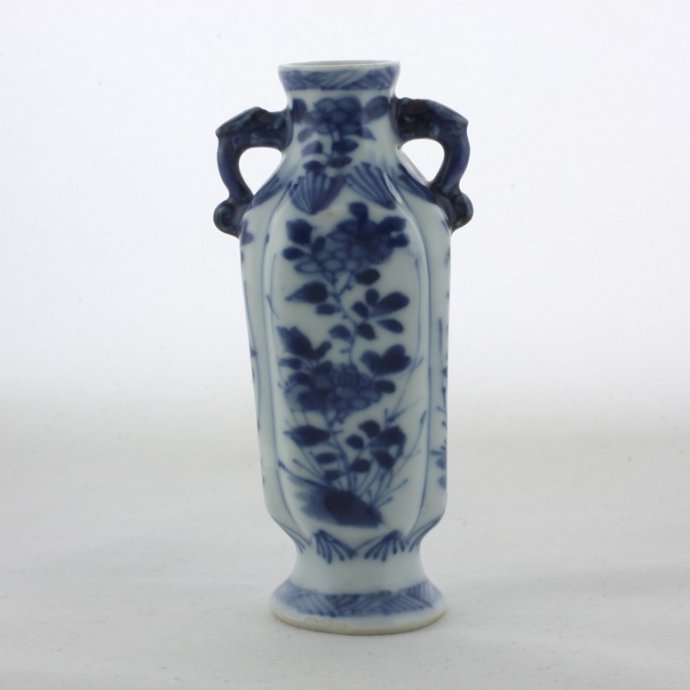
Sold Ceramics - Sold Blue and White Kangxi Period 1662-1722 - Other Vases - Page 1
Object 2011115
Small vase
China
c.1700
Height 96 mm (3.79 inch), diameter 34 mm (1.34 inch), diameter of mouthrim 20 mm (0.79 inch), diameter of footring 29 mm (1.14 inch), weight 75 grams (2.65 ounce (oz.))
A small vase with a splayed foot, a quatrefoil body and a neck with an everted mouth. Two dragon shaped handles. Decorated in underglaze blue around the foot with a zig-zag lines pattern border. On the body, in between two moulded pointed leaves pattern borders, four panels filled with flowering plants. on the neck two sprays of flowering branches and around the rim a zig-zag lines patttern border. The underglaze blue handles are shaped in the form of two dragons. On the base an old collectors number that reads: "37". The vase stands crooked due to the firing process.
For an identically decorated small vase, please see;
Condition: On the body a popped bubble of glaze, caused during the firing process and a glaze rough spot. A restored frit to the rim.
Reference:
Staatliche Schlöser und Gärten 1998, Kat. Nr. 82
Price: Sold.
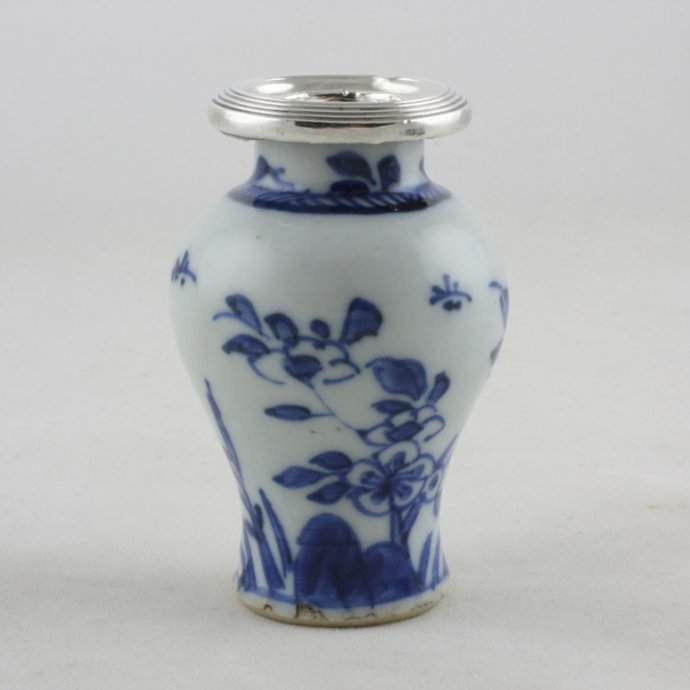
Sold Ceramics - Sold Blue and White Kangxi Period 1662-1722 - Other Vases - Page 1
Object 2010219
Baluster vase / candlestick
China
c.1700
Height 73 mm (2.87 inch), diameter 50 mm (1.97 inch), diameter of mouthrim 18 mm (0.71 inch), diameter of footring 28 mm (1.10 inch), weight 72 grams (2.54 ounce (oz.))
Baluster vase / candlestick on footring. Mounted with an unmarked silver neck. Decorated in underglaze blue with a flowering plant growing from a taihu rock and insects in flight. On the neck a zig-zag lines pattern border.
By placing the silver mount the baluster vase was converted into a candle stick.
Condition: A tiny frit to the footring and some irregular glaze spots to the foot.
Price: Sold.
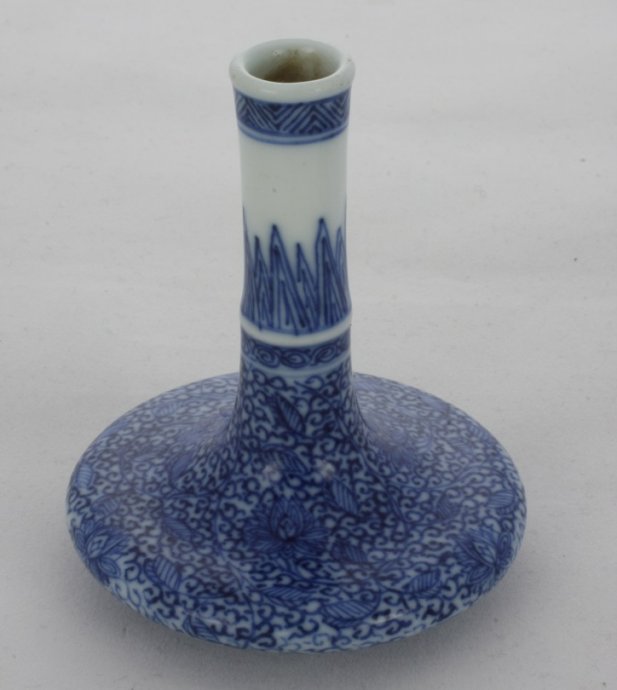
Sold Ceramics - Sold Blue and White Kangxi Period 1662-1722 - Other Vases - Page 1
Object 2010168
Bottle vase
China
c.1700
Height 75 mm (2.95 inch), diameter 54 mm (2.13 inch), diameter of mouthrim 13 mm (0.51 inch), diameter of footring 32 mm (1.26 inch)
Bottle of compressed globular form on a footring with a glazed base. Decorated in underglaze blue. The compressed globular body surmounted by a tall narrow cylindrical neck, painted round the base with scrolls of flowers and leaves. On the shoulder a spiral border, with an upstanding border of lotus leaves, Around the rim a zig-zag lines pattern border. Marked on the base with the six-character mark: Da Ming Xuan de nian zhi, (Made during the Xuande reign of the Great Ming dynasty (1426-1435)), in a double circle, underglaze blue.
An identically decorated bottle is in the collection of The Metropolitan Museum of Art, New York, Accession number 14.40.296.
Condition: A hairline.
Reference:
Price: Sold.

Sold Ceramics - Sold Blue and White Kangxi Period 1662-1722 - Other Vases - Page 1
Object 2010457
Vase
China
1700-1720
Height 98 mm (3.86 inch), diameter 57 mm (2.24 inch), diameter of mouthrim 18 mm (0.71 inch), diameter of footring 27 mm (1.06 inch), weight 85 grams (3.00 ounce (oz.))
Pear-shaped vase on footring. Decorated in underglaze blue with four panels each filled with flowering plants growing from a taihu rock. On the shoulder a zig-zag lines pattern border and two flower sprays. Around the rim a zig-zag lines pattern border.
Condition: Two tiny chips (restored) to the rim.
Price: Sold.

Sold Ceramics - Sold Blue and White Kangxi Period 1662-1722 - Other Vases - Page 1
Object 2010664
Small vase
China
1700-1720
Height 98 mm (3.86 inch), diameter 50 mm (1.97 inch), diameter of mouthrim 13 mm (0.51 inch), diameter of footring 23 mm (0.91 inch), weight 69 grams (2.43 ounce (oz.))
Small, pear-shaped, vase on a footring. Decorated in underglaze blue with flowering plants growing from rockwork with a single flying butterfly. Round the rim a zig-zag lines pattern border. The vase stands crooked due to the firing process.
The decoration on this small vase is similar to that seen on smaller so called ´doll's house vases´ of identical shape that were made during this same period. This particular small vase however is to large to be classified as a ´doll's house vase´.
Condition: Firing flaws to the base, belly and rim. Some shallow glaze fleabites to the mouthrim.
Price: Sold.
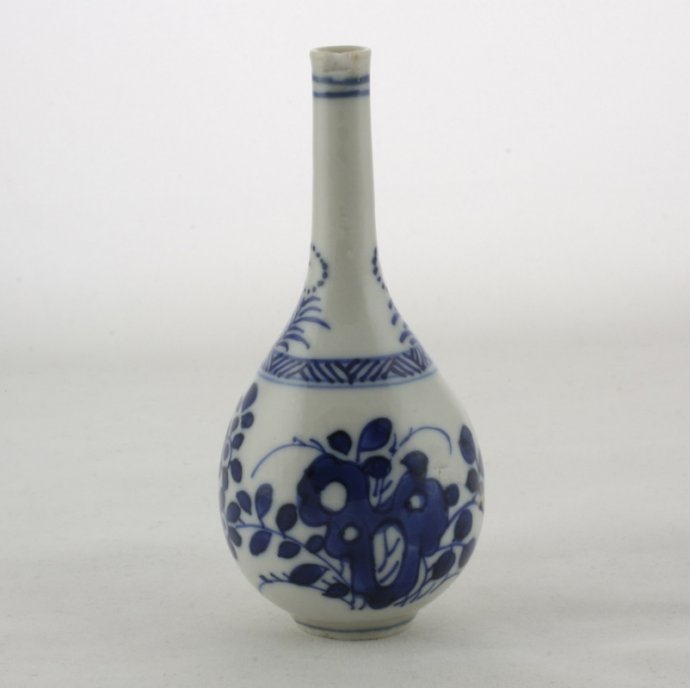
Sold Ceramics - Sold Blue and White Kangxi Period 1662-1722 - Other Vases - Page 1
Object 2011078
Small vase
China
1700-1720
Height 102 mm (4.01 inch), diameter 48 mm (1.77 inch), diameter of mouthrim 10 mm (0.39 inch), diameter of footring: 20 mm (0.78 inch), weight 78 grams (2.75 ounce (oz.))
Small, pear-shaped, vase on footring. Decorated in underglaze blue with flowering plants growing from taihu (garden) rock and a single insect in flight. Round the waist a zig-zag lines-pattern border on the neck two flower sprays.
The decoration on this small vase is similar to that seen on smaller so called 'doll's house vases' of identical shape that were made during this same period. This particular small vase is however too large to be classified as a 'doll's house vase'.
Condition: A chip to the rim and a firing flaw to the inner footring.
Price: Sold.
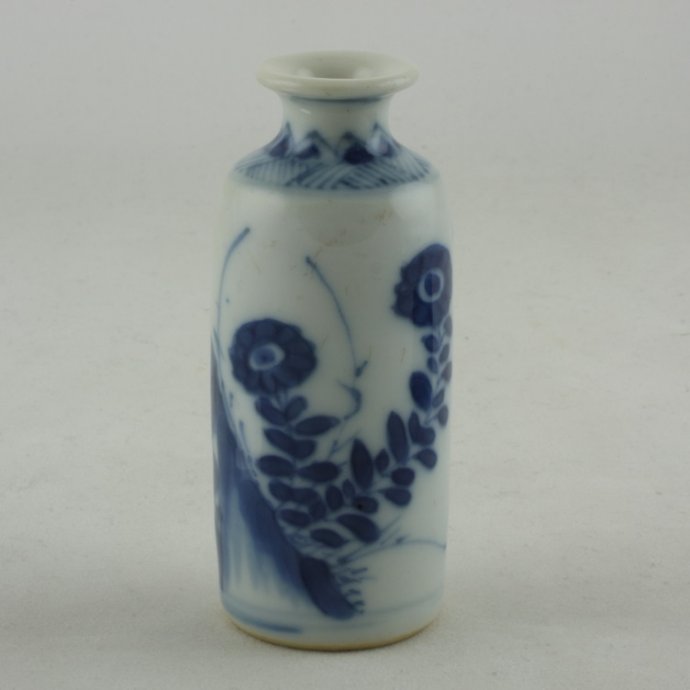
Sold Ceramics - Sold Blue and White Kangxi Period 1662-1722 - Other Vases - Page 1
Object 2010526
Vase
China
1700-1720
Height 75 mm (2.95 inch), diameter 31 mm (1.22 inch), diameter mouthrim 20 mm (0.79 inch), diameter of footring 30 mm (1.18 inch), weight 51 grams (1.80 ounce (oz.))
Small, cylindrical shaped vase on footring with a short neck and a spreading rim. Decorated in underglaze blue with flowering plants growing from rocks and flying insects. On the shoulder a zig-zag lines pattern border and around the neck a lotus leaves pattern border.
Condition: Perfect.
Price: Sold.


 create websites
create websites